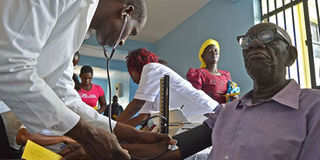Will Kenya achieve its UHC dream?

A medic attends to a patient at Randburg Community Hospital in Nyando, Kisumu. PHOTO | FILE | NATION MEDIA GROUP
What you need to know:
Priority setting remains a path for great potential for Kenya in this journey towards UHC.
This should involve use of evidence to choose not only the most effective, but also the best value for resources.
In September, UN member states adopted a high-level political declaration under the theme ‘Universal Health Coverage (UHC): Moving together to build a healthier world’. This sought to underscore UHC as one of the main targets of Sustainable Development Goals. It further commits to at least one billion more people worldwide receiving adequate, quality health services and without bearing extreme financial burden by 2023. The declaration indeed reinforced the idea that UHC is foremost a ‘political choice’.
SKILLED CARE
Today, we commemorate the third International UHC day on the backdrop of our own affordable healthcare agenda by 2022; one of the four legacy projects of President Uhuru Kenyatta. Since then, UHC has become a pet word for all health-related gatherings.
UHC progress assessment may be based upon Service Coverage Indices (SCI). These include reproductive, maternal, neonatal and child health; infectious disease control; the non-communicable disease burden and service capacity and access. The government’s endeavour to ensure access to skilled care during child delivery, through the Linda Mama programme, leading to at least six out 10 mothers receiving such services, should be commended. Furthermore, currently over half of expectant women now receive at least four antenatal clinical visits, as recommended by WHO.
When we consider infectious diseases, about two-thirds of patients living with HIV are currently on antiretroviral care while diagnosis and treatment of tuberculosis has been timely in most cases.
ERRATIC SUPPLY
It is noteworthy that donor championing of this cause has played a big role in the progress. And subsequently diminishing donor support in the recent past, partly due to rebasing of the Kenyan economy among other factors, has slowed down the momentum in these programmes.
The last two SCI for UHC remain uncharted waters. More than 70 per cent of deaths worldwide are attributable to NCDs and four out of five people with an NCD live in a low or middle-income country like Kenya. The rising concern for NCDs is palpable, with cases of morbidity and mortality from cancers, cardiovascular diseases, diabetes and chronic respiratory diseases now commonplace.
Considering service access and capacity for UHC, while the total number of health facilities has increased, the health service provision is still unreliable, with erratic medicines supply in public facilities. The user fees levied by some public health facilities greatly limit access to service.
SOCIAL CONTRACT
According to the World Health Organisation (WHO), out-of-pocket health spending on healthcare is the greatest impediment to UHC for middle-income countries, and Kenya is one such country. Furthermore the public health workforce density remains low, compounded by an icy relationship with the employers as evidenced by the frequent and long industrial actions. As we pensively reflect on the idea that UHC is a political choice that a government must make, the question then becomes whether this government has the gravitas to actualise this social contract, between it and the people, of earmarking adequate resources to actualise UHC?
LIMITING SERVICES
To answer this question, it is imperative to understand that the sure path to UHC would be adequate government health expenditure relative to total health expenditure. In 2018/19, this ratio stands at 6.8 per cent for Kenya, way below the recommended 15 per cent. It is the shortfalls in the health systems that are passed on to patients as out-of-pocket health expenditure in form of consultation fees, laboratory charges, purchase of prescribed drugs and admission fees. These result in limiting access to these health services.
It was hoped the Kenyan journey to UHC would be through health insurance reforms. This would have expanded access to health services by ensuring more Kenyans get a variety of packages for the prepaid premium to the National Hospital Insurance Fund (NHIF). In the past five years, NHIF has been instrumental in enabling access to health services among populations hitherto at risk such as selected poor and vulnerable children through the Health Insurance Subsidy Programme, inclusion of outpatient services and coverage of special services that include chronic diseases, variety of imaging services and cancer care. It is, however, notable that antipathy towards NHIF is rife within the Kenyan public and further reforms are long overdue.
POLICY SELECTION
It is key that during these reforms the public is involved as stakeholders.
Priority setting remains a path for great potential for Kenya in this journey towards UHC. This should involve use of evidence to choose not only the most effective, but also the best value for resources should determine the selection of policy, health products and technologies, clinical management pathways and organisational support.
Dr Mulaa is a pharmacist and health economist. [email protected]




